Abstract
Objective Tacrolimus is an immunosuppressive drug with narrow therapeutic range and wide interindividual variation in its pharmacokinetics. Tacrolimus is a substrate of cytochrome P450(CYP)3A5. The aim of this study was to evaluate whether the A6986G polymorphism is associated with tacrolimus concentration /dose ratio. Methods Fifty-two Chinese renal transplant patients were enrolled in this study. Their body weight, dosage and concentration of tacrolimus were observed. CYP3A5 genotype was determined by polymerase chain reaction followed by restriction fragment length polymorphism analysis. Results A significant association was found between tacrolimus levels per dose/kg/d and CYP3A5 gene A6986G polymorphism (P<0.001). The CYP3A5 * 3 * 3 patients have a significantly higher tacrolimus level/dose than CYP3A5 * 1 * 1 and CYP3A5 * 1 * 3. Conclusions CYP3A5 gene A6986G polymorphism is associated with tacrolimus pharmacokinetics and dose requirements. Pharmacogenetic methods could be employed prospectively to help the dose selection and to individualize immunosuppressive therapy according to the result.
Similar content being viewed by others
References
Andrews P A, Sen M, Chang R W. Racial variation in dosage requirements of tacrolimus[J]. Lancet, 1996, 348(9039): 1446.
MacPhee I A, Fredericks S, Tai T, et al. Tacrolimus pharmacogenetics: polymorphisms associated with expression of cytochrome P4503A5 and P-glycoprotein correlate with dose requirement[J]. Transplantation, 2002, 74(11): 1486–1495.
Neylan J F. Racial Differences in renal transplantation after immunosuppression with tacrolimus versus cyclosporine[J]. Transplantation, 1998, 65 (4): 515–523.
Simpson D, Noble S. Tacrolimus ointment: a review of its use in atopic dermatitis and its clinical potential in other inflammatory skin conditions [J]. Drugs, 2005, 65(6): 827–858.
Zheng H X, Webber S, Zeevi A, et al. Tacrolimus dosing in pediatric heart transplant patients is related to CYP3A5 and MDR1 gene polymorphisms[J]. Am J Transplant, 2003, 3(4): 477–483.
Meiser B M. The best dosing for initial tacrolimus application is trough level adapted[J]. Transplantation. 2005, 79(1): 10–11.
Author information
Authors and Affiliations
Corresponding author
Additional information
Foundation item: Project (03GZ3072) supported by the Science and Technology Department of Hunan Province; project (2004035206) supported by the China Postdoctoral Foundation and project (30300383) supported by the National Natural Sciences Foundation of China
Rights and permissions
About this article
Cite this article
Nie, Xm., Gui, R., Zhao, Hs. et al. Influence of CYP3A5 polymorphism on tacrolimus blood concentrations in renal transplant patients. J Cent. South Univ. Technol. 12 (Suppl 1), 310–312 (2005). https://doi.org/10.1007/s11771-005-0419-9
Received:
Accepted:
Published:
Issue Date:
DOI: https://doi.org/10.1007/s11771-005-0419-9




